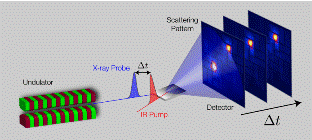Department of Physics and Astronomy: Publications and Other Research

Matthias Fuchs Publications
Document Type
Article
Date of this Version
2014
Citation
PHYSICAL REVIEW LETTERS 112 (2014); DOI: 10.1103/PhysRevLett.112.163901
Abstract
It is now 40 years since Freund [1] and Eisenberger [2] and colleagues described a theory for the nature of a solidstate dense plasma nonlinearity that is operative at x-ray wavelengths. The main assumption of this model is that since all pertinent photon energies are much higher than the binding energies of the electrons in light elements, the electrons can be treated as free particles, and the dominant nonlinearity is a plasmalike nonlinearity. This nonlinearity is very different from conventional nonlinearities in the visible regime. It is nonlocal, second order, and may be observed in centrosymmetric materials, but requires a nonuniform electron density. Unlike visible light, which interacts only with valence electrons, x-ray radiation interacts with both the valence and core electrons. It is well known that if the interacting photon energies are all above the electron binding energies, as in the case of the x rays, the magnitudes of nonlinearities are very small. Consequently, previous to the work reported here, hard x-ray nonlinearities have only been observed in parametric down-conversion [2–9]. The key factor for those experiments is the large number of vacuum fluctuation modes at x-ray wavelengths. Thus, although the parametric gain is very small, coincidences of the generated signal and idler photons can be measured even when the pump source is an x-ray tube [2]. X-ray free electron lasers (XFELs) are revolutionizing the study of atomic-scale structure and dynamics [10–17]. For applications including coherent imaging, focused intensities in excess of 1019 W=cm2 are often used [18]. At these intensities, the x-ray matter interaction is characterized by multiple sequential ionization, raising questions for interpretation of experiments [10–17,19]. Recently, Glover and colleagues have demonstrated the nonlinear wave mixing of x-ray and near-infrared beams [20]. However, the efficiency in those experiments depends on the intensity of the infrared laser and not on the intensity of the x-ray laser. On the other hand, the high peak power of the XFEL is critical for the observation of most x-ray nonlinear effects. For example, the theory based on the plasma nonlinearity predicts that the observation of x-ray second harmonic generation (SHG) requires pump intensities exceeding 1015 W=cm2. These intensities are orders of magnitude larger than the damage threshold in the visible regime, and the corresponding electric field strengths are nearly the atomic field.


Comments
Copyright © 2014 American Physical Society. Used by permission.